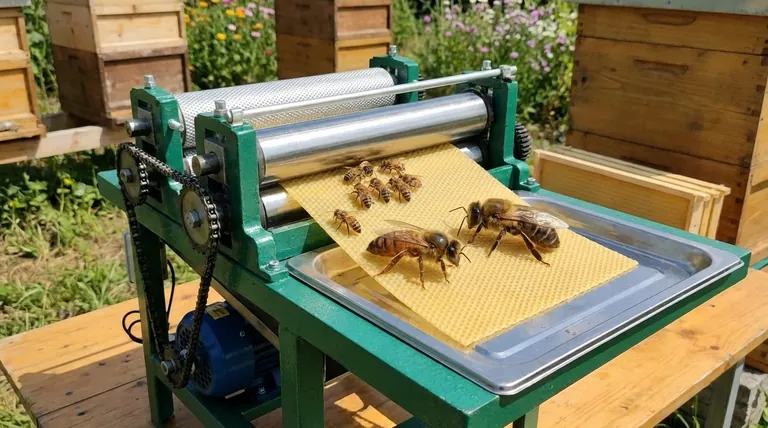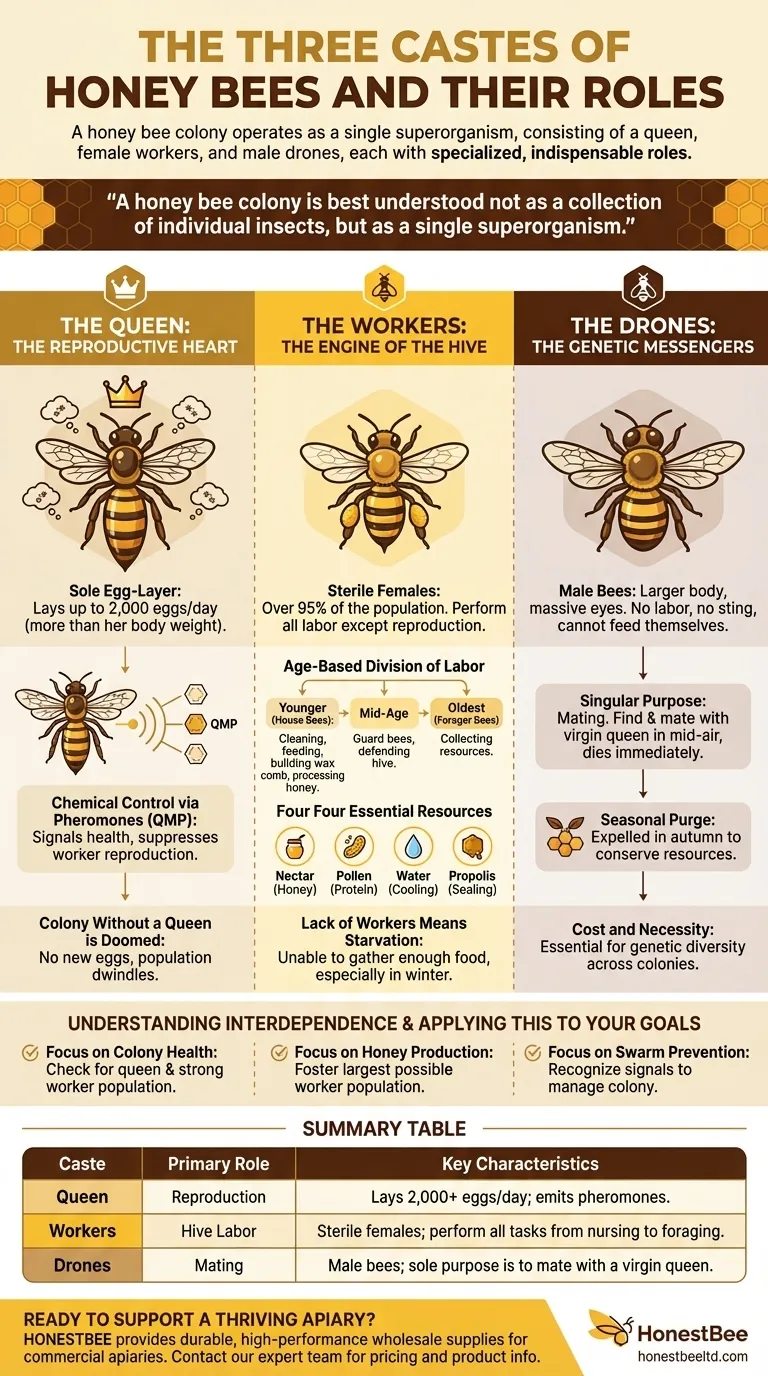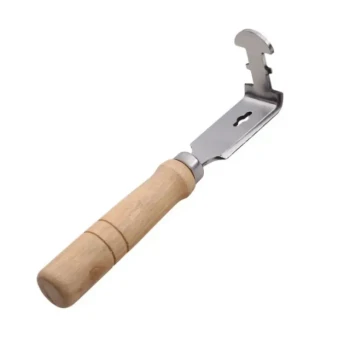At its core, a honey bee colony operates with three distinct castes: the single queen, the all-female workers, and the male drones. The queen is the sole reproductive female, the workers perform all the labor required to maintain and grow the colony, and the drones' only purpose is to mate with a queen from another hive. Each caste is completely dependent on the others for survival.
A honey bee colony is best understood not as a collection of individual insects, but as a single superorganism. The queen, workers, and drones function like specialized organs, each performing an indispensable role that ensures the survival and continuity of the whole.

The Queen: The Reproductive Heart
A healthy colony has only one queen. Her presence and health dictate the mood, stability, and future of the entire hive.
### The Sole Egg-Layer
The queen's primary function is reproduction. During her peak, she can lay up to 2,000 eggs per day, more than her own body weight. This incredible output is necessary to constantly replenish the hive's population.
### Chemical Control via Pheromones
The queen produces a unique chemical scent known as queen mandibular pheromone (QMP). This scent spreads throughout the hive, signaling to all members that she is present and healthy. It also suppresses the reproductive systems of the worker bees, ensuring she remains the only egg-layer.
The Workers: The Engine of the Hive
Worker bees are sterile females that make up over 95% of the colony's population. They are responsible for every task except reproduction.
### An Age-Based Division of Labor
A worker bee's job changes as she ages. This progression ensures all tasks are covered efficiently.
Younger workers (house bees) stay inside the hive. Their initial jobs include cleaning cells, feeding larvae, tending to the queen, building wax comb, and processing nectar into honey.
As they age, workers take on roles with more risk. They may become guard bees, defending the hive entrance, before finally graduating to become forager bees.
### The Foraging Force
Foragers are the oldest and most experienced workers. They perform the dangerous work of leaving the hive to collect the four resources essential for survival: nectar, pollen, water, and propolis (a resin used for sealing the hive).
The Drones: The Genetic Messengers
Drones are the male bees in the colony. They are larger than workers, with massive eyes designed to spot queens in flight.
### A Singular Purpose: Mating
A drone has only one job: to mate with a virgin queen. They contribute no labor to the hive, do not have stingers, and cannot even feed themselves effectively.
Drones leave the hive on warm, sunny afternoons to congregate in specific areas called drone congregation areas, where they wait for a queen to fly by. Mating occurs in mid-air, and the drone dies immediately after.
### The Seasonal Purge
Because they are a significant drain on the hive's resources, drones are typically expelled from the colony in the autumn. As resources dwindle, the workers will stop feeding the drones and force them out of the hive to starve, ensuring the colony has enough food to survive the winter.
Understanding the Interdependence
The caste system is a model of perfect collaboration, but it's also a system of absolute dependency. The failure of one caste guarantees the failure of the colony.
### A Colony Without a Queen is Doomed
If a queen dies and the workers cannot raise a replacement, the colony is considered "queenless." With no new eggs being laid, the population will dwindle and eventually collapse.
### A Lack of Workers Means Starvation
Even with a healthy queen, a weak or declining worker force cannot gather enough food or care for the young. The colony will be unable to sustain itself, especially through winter.
### The Cost and Necessity of Drones
While drones seem like a burden on an individual hive, they are essential for the genetic diversity and long-term health of the entire honey bee species. Their role ensures that genes are mixed between different colonies.
Applying This to Your Goals
Understanding these roles is the first step to diagnosing a colony's health and guiding its success.
- If your primary focus is colony health: Regularly check for signs of a healthy, laying queen (seeing eggs and larvae) and a robust population of workers.
- If your primary focus is honey production: Your goal is to foster the largest possible worker population, as they are the bees that collect the nectar that becomes honey.
- If your primary focus is swarm prevention: Recognizing the signals that precede swarming—driven by the queen and workers—allows you to manage the colony and prevent it from dividing.
This intricate social structure is what makes the honey bee colony one of nature's most successful and resilient organisms.
Summary Table:
| Caste | Primary Role | Key Characteristics |
|---|---|---|
| Queen | Reproduction | Lays up to 2,000 eggs/day; emits pheromones to control the hive. |
| Workers | Hive Labor | Sterile females; perform all tasks from nursing to foraging. |
| Drones | Mating | Male bees; sole purpose is to mate with a virgin queen from another hive. |
Ready to support a thriving apiary? Understanding the intricate social structure of your bees is the first step to success. As a leading wholesale supplier, HONESTBEE provides commercial apiaries and beekeeping equipment distributors with the durable, high-performance supplies needed to manage healthy, productive colonies. From hive components to protective gear, our products are designed to meet the demands of large-scale operations. Let's discuss how we can support your business goals. Contact our expert team today for wholesale pricing and product information.
Visual Guide

Related Products
- Electric Flatting and Embossing Machine with Tray for Beekeeping
- Professional Galvanized Hive Strap with Secure Locking Buckle for Beekeeping
- Nicot Queen Rearing Kit for Beekeeping and Grafting in Nicot System
- Mesh Ventilated 3 Layer Goatskin Beekeepers Gloves for Beekeeping
- Vertical Motor Kits for 2 3 4 Frame Electric Honey Extractors
People Also Ask
- What tools are used to cut wax foundations? The Essential Guide for a Perfect Fit
- What are the main components of a beeswax foundation sheet machine? A Guide to Efficient Production
- What is the importance of soaping the rollers during milling? Prevent Wax Adhesion & Equipment Downtime
- What qualities are important for someone starting in beekeeping? Build a Thriving Apiary with the Right Mindset
- What is the use of a comb foundation mill? Boost Honey Production with Strategic Hive Control



















